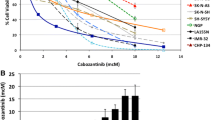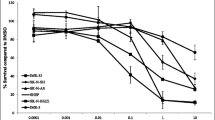Abstract
Background
Children with high-risk neuroblastoma have poor survival rates, and novel therapies are needed. Previous studies have identified a role for the HGF/c-Met pathway in neuroblastoma pathogenesis. We hypothesized that EMD1214063 would be effective against neuroblastoma tumor cells and tumors in preclinical models via inhibition of HGF/c-Met signaling. Methods We determined the expression of c-Met protein by Western blots in a panel of neuroblastoma tumor cell lines and neuroblastoma cell viability after treatment with EMD1214063 using MTT assays. TUNEL assays and assays for DNA ladder formation, were performed to measure the induction of apoptosis after EMD1214063 treatment. Inhibition of intracellular signaling was measured by Western blot analysis of treated and untreated cells. To investigate the efficacy of EMD1214063 against neuroblastoma tumors in vivo, neuroblastoma cells were injected orthotopically into immunocompromised mice, and mice were treated with oral EMD1214063. Tumors were evaluated for growth, histologic appearance, and induction of apoptosis by immunohistochemistry. Results All neuroblastoma cell lines were sensitive to EMD1214063, and IC50 values ranged from 2.4 to 8.5 μM. EMD1214063 treatment inhibited HGF-mediated c-Met phosphorylation and MEK phosphorylation in neuroblastoma cells. EMD1214063 induced apoptosis in all tested cell lines. In mice with neuroblastoma xenograft tumors, EMD1214063 treatment reduced tumor growth. Conclusions Treatment of neuroblastoma tumor cells with EMD1214063 inhibits HGF-induced c-Met phosphorylation and results in cell death. EMD1214063 treatment is also effective in reducing tumor growth in vivo. EMD1214063 therefore represents a novel therapeutic agent for neuroblastoma, and further preclinical studies of EMD1214063 are warranted.






Similar content being viewed by others
Abbreviations
- COG:
-
Children’s Oncology Group
- TUNEL:
-
Terminal deoxynucleotidyl transferase dUTP nick end labeling
- ATCC:
-
American Type Culture Collection
- SDS-PAGE:
-
Sodium dodecyl sulfate-polyacrylamide gel electrophoresis
- 7-AAD:
-
7-amino-actinomycin
- FBS:
-
Fetal bovine serum
- HGF:
-
Hepatocyte growth factor
- NGF:
-
Nerve growth factor
- DMEM:
-
Dulbecco’s modified Eagle’s medium
- MTT:
-
3-(4,5 dimethylthiazolyl-2-yl)-2,5-diphenyltetrazolium bromide
References
Ladenstein R, Philip T, Lasset C, Hartmann O, Zucker JM, Pinkerton R et al (1998) Multivariate analysis of risk factors in stage 4 neuroblastoma patients over the age of one year treated with megatherapy and stem-cell transplantation: a report from the European bone marrow transplantation solid tumor registry. J Clin Oncol 16:953–65
Matthay KK, Reynolds CP, Seeger RC, Shimada H, Adkins ES, Haas-Kogan D et al (2009) Long-term results for children with high-risk neuroblastoma treated on a randomized trial of myeloablative therapy followed by 13-cis-retinoic acid: a Children’s Oncology Group study. J Clin Oncol 27:1007–13
Zage PE, Kletzel M, Murray K, Marcus R, Castleberry R, Zhang Y et al (2008) Outcomes of the POG 9340/9341/9342 trial for children with high-risk Neuroblastoma: a report from the Children’s Oncology Group. Pediatr Blood Cancer 51:747–53
Lau L, Tai D, Weitzman S, Grant R, Baruchel S, Malkin D (2004) Factors influencing survival in children with recurrent neuroblastoma. J Pediatr Hematol Oncol 26:227–32
London WB, Castel V, Monclair T, Ambros PF, Pearson ADJ, Cohn SL et al (2011) Clinical and biologic features predictive of survival after relapse of neuroblastoma: a report from the International Neuroblastoma Risk Group project. J Clin Oncol 29:3286–92
Matsui T, Sano K, Tsukamoto T, Ito M, Takaishi T, Nakata H et al (1993) Human neuroblastoma cells express alpha and beta platelet-derived growth factor receptors coupling with neurotrophic and chemotactic signaling. J Clin Invest 92:1153–60
Cohen PS, Chan JP, Lipkunskaya M, Biedler JL, Seeger RC (1994) Expression of stem cell factor and c-kit in human neuroblastoma. The Children’s Cancer Group. Blood 84:3465–72
Janet T, Ludecke G, Otten U, Unsicker K (1995) Heterogeneity of human neuroblastoma cell lines in their proliferative responses to basic FGF, NGF, and EGF: correlation with expression of growth factors and growth factor receptors. J Neurosci Res 40:707–15
Eggert A, Ikegaki N, Kwiatkowski J, Zhao H, Brodeur GM, Himelstein BP (2000) High-level expression of angiogenic factors is associated with advanced tumor stage in human neuroblastomas. Clin Cancer Res 6:1900–8
Langer I, Vertongen P, Perret J, Fontaine J, Atassi G, Robberecht P (2000) Expression of vascular endothelial growth factor (VEGF) and VEGF receptors in human neuroblastomas. Med Pediatr Oncol 34:386–93
Hecht M, Papoutsi M, Tran HD, Wilting J, Schweigerer L (2004) Hepatocyte growth factor/c-Met signaling promotes the progression of experimental human neuroblastomas. Cancer Res 64:6109–18
Meyers MB, Shen WP, Spengler BA, Ciccarone V, O’Brien JP, Donner DB et al (1988) increased epidermal growth factor receptor in multidrug-resistant human neuroblastoma cells. J Cell Biochem 38:87–97
Ho R, Minturn JE, Hishiki T, Zhao H, Wang Q, Cnaan A et al (2005) Proliferation of human neuroblastomas mediated by the epidermal growth factor receptor. Cancer Res 65:9868–75
Meister B, Grunebach F, Bautz F, Brugger W, Fink FM, Kanz L, Mohle R (1999) Expression of vascular endothelial growth factor (VEGF) and its receptors in human neuroblastoma. Eur J Cancer 35:445–9
Fakhari M, Pullirsch D, Paya K, Abraham D, Hofbauer R, Aharinejad S (2002) Upregulation of vascular endothelial growth factor receptors is associated with advanced neuroblastoma. J Pediatr Surg 37:582–7
Crosswell HE, Dasgupta A, Alvarado CS, Watt T, Christensen JG, De P et al (2009) PHA665752, a small-molecule inhibitor of c-Met, inhibits hepatocyte growth factor-stimulated migration and proliferation of c-met-positive neuroblastoma cells. BMC Cancer 9:411
Gherardi E, Birchmeier W, Birchmeier C, Vande Woude G (2012) Targeting MET in cancer: rationale and progress. Nat Rev Cancer 12:89–103
Scagliotti GV, Novello S, von Pawel J (2013) The emerging role of MET/HGF inhibitors in oncology. Cancer Treat Rev 39:793–801
Bladt F, Faden B, Friese-Hamim M, Knuehl C, Wilm C, Fittschen C et al (2013) EMD1214063 and EMD1204831 constitute a new class of potent and highly selective c-Met inhibitors. Clin Cancer Res 19:2941–51
Humbert M, Medova M, Aebersold DM, Blaukat A, Bladt F, Fey MF et al (2013) Protective autophagy is involved in resistance towards MET inhibitors in human gastric adenocarcinoma cells. Biochem Biophys Res Commun 431:264–9
Falchook GS, Hong DS, Amin HM, Fu S, Piha-Paul SA, Janku F et al (2013) Phase I study of oral selective c-Met inhibitor EMD1214063 in Pts with advanced solid tumors. J Clin Oncol 31:2506
Yan B, Lim M, Zhou L, Kuick CH, Leong MY, Yong KJ et al (2013) Identification of MET genomic amplification, protein expression, and alternative splice isoforms in neuroblastomas. J Clin Pathol. doi:10.1136/jclinpath-2012-201375, ePub June 25, 2013
Biedler JL, Helson L, Spengler BA (1973) Morphology and growth, tumorigenicity, and cytogenetics of human neuroblastoma cells in continuous culture. Cancer Res 33:2643–52
Brodeur GM, Green AA, Hayes FA, Williams KJ, Williams DL, Tsiatis AA (1981) Cytogenetic features of human neuroblastomas and cell lines. Cancer Res 41:4678–86
Reynolds CP, Tomayko MM, Donner L, Helson L, Seeger RC, Triche TJ, Brodeur GM (1988) biological classification of cell lines derived from human extra-cranial neural tumors. Prog Clin Biol Res 271:291–306
Foley J, Cohn SL, Salwen HR, Chagnovich D, Cowan J, Mason KL, Parysek LM (1991) Differential expression of N-myc in phenotypically distinct subclones of a human neuroblastoma cell lines. Cancer Res 51:6338–45
Zage PE, Zeng L, Palla S, Fang W, Nilsson MB, Heymach JV, Zweidler-McKay PA (2010) A novel therapeutic combination for neuroblastoma: the VEGFR/EGFR/RET inhibitor Vandetanib With 13-Cis-retinoic acid. Cancer 116:2465–75
Zage PE, Graham TC, Zeng L, Fang W, Pien C, Thress K et al (2011) The selective Trk inhibitor AZ623 inhibits BDNF-mediated neuroblastoma cell proliferation and signaling and is synergistic with topotecan. Cancer 117:1321–9
Richards KN, Zweidler-McKay PA, Van Roy N, Speleman F, Trevino J, Zage PE, Hughes DPM (2010) Signaling of ERBB receptor tyrosine kinases promotes neuroblastoma growth in vitro and in vivo. Cancer 116:3233–43
Patterson DM, Shohet JM, Kim ES (2011) Preclinical models of pediatric solid tumors (Neuroblastoma) and their use in drug discovery. Curr Protoc Pharmacol 52:14.17.1–14.17.18
Arriola E, Canadas I, Arumi-Uria M, Domine M, Lopez-Vilarino JA, Arpi O et al (2011) MET phosphorylation predicts poor outcome in small cell lung carcinoma and its inhibition blocks HGF-indcued effects in MET mutant cell lines. Br J Cancer 105:814–23
Srivastava R, Geng D, Liu Y, Zheng L, Li Z, Joseph MA et al (2012) Augmentation of therapeutic responses in melanoma by inhibition of IRAK-1, -4. Cancer Res 72:6209–16
Chuang J-H, Chuang H-C, Huang C-C, Wu C-L, Du Y-Y, Kung M-L et al (2011) Differential toll-like receptor 3 (TLR3) expression and apoptotic response to TLR3 agonist in human neuroblastoma cells. J Biomed Sci 18:65
Pugh TJ, Morozova O, Attiyeh EF, Asgharzadeh S, Wei JS, Auclair D et al (2013) The genetic landscape of high-risk neuroblastoma. Nat Genet 45:279–87
George RE, Attiyeh EF, Li S, Moreau LA, Neuberg D, Li C et al (2007) Genome-wide analysis of neuroblastomas using high-density single nucleotide polymorphism arrays. PLoS One 2:e255
Katayama R, Aoyama A, Yamori T, Qi J, Oh-hara T, Song Y et al (2013) Cytotoxic activity of tivantinib (ARQ197) is not due solely to c-Met inhibition. Cancer Res 73:3087–96
Basilico C, Pennacchietti S, Vigna E, Chiriaco C, Arena S, Bardelli A et al (2013) Tivantinib (ARQ197) displays cytotoxic activity that is independent of its ability to bind MET. Clin Cancer Res 19:2381–92
Grant support
This study was supported by an Independent Medical Grant from EMD Serono, Inc. to PEZ in the form of research funding and study drug.
Conflict of interest
This study was supported by an Independent Medical Grant from EMD Serono, Inc. to PEZ in the form of research funding and study drug. All other authors declare that they have no conflict of interest.
Author information
Authors and Affiliations
Corresponding author
Electronic supplementary material
Below is the link to the electronic supplementary material.
Online Resource 1
Effects of EMD1214063 on neuroblastoma tumor cell morphology. Neuroblastoma tumor cells were treated with increasing concentrations of EMD1214063 for 24 hours, and photographs of cell appearance were obtained. (PDF 34 kb)
Online Resource 2
c-Met expression in neuroblastoma patient tumor samples. Protein lysates from neuroblastoma patient tumors and control cell lines were evaluated for expression of c-Met by Western blot. 3 samples were determined to be positive (#'s 3, 6, and 7). b-actin was used as a control for protein loading. (PDF 29212 kb)
Rights and permissions
About this article
Cite this article
Scorsone, K., Zhang, L., Woodfield, S.E. et al. The novel kinase inhibitor EMD1214063 is effective against neuroblastoma. Invest New Drugs 32, 815–824 (2014). https://doi.org/10.1007/s10637-014-0107-4
Received:
Accepted:
Published:
Issue Date:
DOI: https://doi.org/10.1007/s10637-014-0107-4




